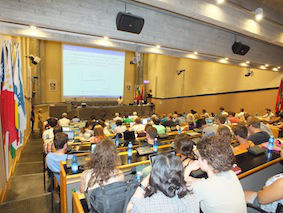Speaker
Description
Electrons (and positrons) are unique among the cosmic-ray species. Due to their relatively low masses, they are more strongly affected by the large-scale magnetic fields which govern cosmic-ray diffusion in the Galaxy. Source modeling indicates that a nearby accelerator such as the Vela supernova remnant could produce a clear signature in the energy spectrum of cosmic-ray electrons at TeV energies. In addition, some dark matter candidates could decay through a leptonic channel, producing a line signature in the electron spectrum at an energy governed by their masses.
This talk will discuss the motivation for and the current state of direct observations of cosmic-ray electrons, mostly in the context of the Calorimetric Electron Telescope (CALET). CALET is a current, space-based cosmic-ray electron telescope on the International Space Station (ISS) designed for direct, calorimetric detection of electrons at 1 GeV–10+ TeV energies, gamma rays at 1 GeV–1 TeV energies, and cosmic-ray hadrons up to PeV energies. Electromagnetic calorimetry, detector calibration and response, and the detection and reconstruction of cosmic-ray events will be summarized in the context of CALET, and current results will be compared with those of other instruments, including DAMPE, AMS-02, and Fermi-LAT. Finally, the analysis of photon events and their similarities to electrons will be summarized.

